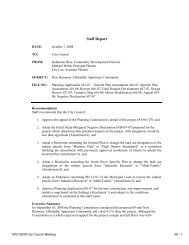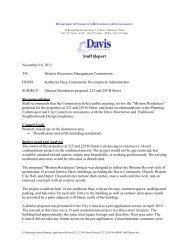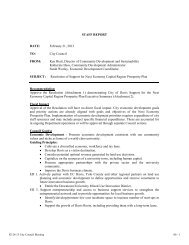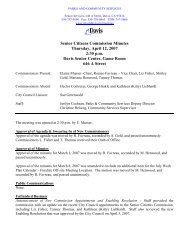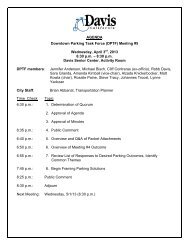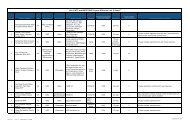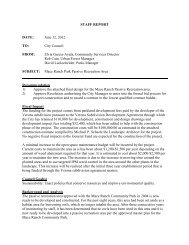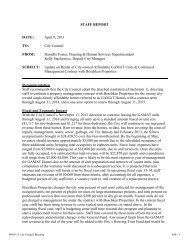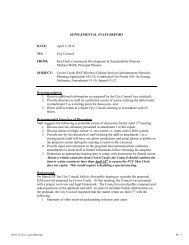10 Draft Integrated Waste Management Plan - City Council - City of ...
10 Draft Integrated Waste Management Plan - City Council - City of ...
10 Draft Integrated Waste Management Plan - City Council - City of ...
Create successful ePaper yourself
Turn your PDF publications into a flip-book with our unique Google optimized e-Paper software.
2012 Davis <strong>Integrated</strong> <strong>Waste</strong> <strong>Management</strong> <strong>Plan</strong><br />
<strong>of</strong> waste into a single 65 gallon garbage cart. Recycling service is provided at no additional cost, only trash has<br />
a charge associated with collection. So if a family generates more than the typical amount <strong>of</strong> waste, looking<br />
closer at what recyclables are still in their waste should reduce their amount <strong>of</strong> trash, increase their recycling<br />
and keep them using a smaller garbage cart, effectively saving money.<br />
Another argument in favor <strong>of</strong> a variable can rate structure is one <strong>of</strong> social engineering: if you provide people<br />
with a smaller sized garbage cart, they will generate less waste (this idea <strong>of</strong> “right sizing” a garbage cart is<br />
based on today’s world <strong>of</strong> extensive recycling programs, composting options and reducing waste). This also<br />
brings up the discussion about equitable billing. Why should customers who generate less waste pay the same<br />
as customers who generate more? Those who generate more waste probably should pay more for the additional<br />
recycling outreach required to shift behavior.<br />
Small garbage carts may fill more quickly. Experience in other jurisdictions with single-family variable can rate<br />
structures shows that when customers are confronted with a full garbage container, they will put excess garbage<br />
in the recycling container. This has a negative impact on the quality <strong>of</strong> the recycled material. As part <strong>of</strong> a switch<br />
to a variable can rate, additional outreach will have to be generated during the holidays to ensure that excess<br />
trash does not go into the recycling cart.<br />
If the <strong>City</strong> were to switch to a single-family variable can rate structure, an outreach campaign would need to be<br />
launched to target customers that switch from a 96 gallon cart to a 65 or 32 gallon cart size. The campaign<br />
would address the necessity <strong>of</strong> separating out recyclables to prevent customers from placing excess trash in their<br />
recycling carts.<br />
If the <strong>City</strong> wants to change to a single-family variable can rate structure, such a change would need to be<br />
reflected in the contract with DWR, requiring a contract amendment. The <strong>City</strong> would also need to give DWR<br />
adequate time to order and distribute new garbage carts.<br />
The <strong>City</strong> might consider setting the default customer size at 65 gallons, and build a rate structure above and<br />
below the 65 gallon charge. Rate comparisons could be done using cities <strong>of</strong> similar size and approximate<br />
transportation costs (see Table O-4).<br />
<strong>City</strong> <strong>Council</strong> may next consider switching to a single-family variable can rate in June 2013 as part <strong>of</strong> the<br />
Proposition 218 rate process. The <strong>City</strong> is working on a survey <strong>of</strong> single-family residents that will include<br />
questions about cart size, how full carts typically are on pick-up day, and how they feel about a variable can rate<br />
structure. The results <strong>of</strong> this survey will be presented to <strong>Council</strong> when they meet to discuss the possibility <strong>of</strong><br />
switching to a single-family variable can rate structure.<br />
DRAFT<br />
It is important to note the time required under the Proposition 218 process for rate changes. After approval <strong>of</strong><br />
the rate structure, the <strong>City</strong> would need to prepare and send a Public Hearing notice to customers. The notice<br />
must be mailed 60 days before the Public Hearing date. At the Public Hearing (which occurs during two <strong>City</strong><br />
<strong>Council</strong> meetings) the rate change must be read twice (September 2013); <strong>Council</strong> can vote to approve the rate<br />
change after the second reading. Forty five days after the approval the rates can go into effect (December<br />
2013). This same process would be repeated with every rate change that is required.<br />
<strong>Council</strong> gives staff direction to proceed with variable can rate—September 25, 2012<br />
<strong>Council</strong> approves rate structures—April 2013<br />
<strong>Council</strong> approves Prop 218 Notice—June 2013<br />
<strong>Council</strong> approves rates—September 2013<br />
Page | 8-75



